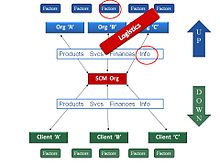Military supply-chain management
The examples and perspective in this articledeal primarily with the United States and do not represent aworldwide viewof the subject.(September 2023) |
| Part of a series on |
| War Outline |
|---|
 |
Military supply-chain managementis a cross-functional approach toprocuring,producinganddeliveringproductsandservicesfor militarymaterielapplications. Militarysupply chain managementincludes sub-suppliers, suppliers, internal information andfunds flow.[1]
Terminology[edit]
A supply involves theprocurement,distribution,maintenancewhile instorage,and salvage of supplies, including the determination of kind andquantityof supplies.United States Department of Defensedefinitions refer to a "producer phase" and a "consumer phase":
- the producer phase of a military supply extends from determination of procurement schedules to acceptance of finished supplies by themilitary services
- the consumer phase of a military supply extends from receipt of finished supplies by the military services, through issue for use orconsumption.[2]
Asupply chainis a set of linked activities associated with providing material from araw materialstage to an end user as afinished good.[3]
Supply control is the process by which an item of supply is controlled within the supply system, including requisitioning, receipt, storage,stock control,shipment,disposition,identification,andaccounting.[4]
A supply point is a location where supplies, services and materials are located and issued. As a single moving entity,[5]a supply point location is temporary and mobile, normally being occupied for up to 72 hours.[6]
Sub-suppliers are those suppliers who provide materials to other suppliers within the supply chain. In other supply chain management contexts they are referred to by tier, second-tier suppliers serving first-tier suppliers, etc.[7]TheEuropean Unionrefers to sub-suppliers in its objective to improve cross-border market access in the defence sector.[8]
Logistics[edit]

Military logisticsis the science of planning and carrying out the movement and maintenance ofarmed forces.In its most comprehensive sense, those aspects ofmilitary operationsthat deal with: a.designanddevelopment,acquisition,storage,movement,distribution,maintenance,evacuation,anddispositionof materiel; b. movement, evacuation, andhospitalizationof personnel; c. acquisition orconstruction,maintenance, operation and disposition of facilities; and d. acquisition or furnishing of services.[9]
The main difference between the concept of logistic management and supply-chain management is the level of information gathered, processes, analysed and used for decision making. An SCM-based organization not only having concerns with its immediate clients but also handles and forecasts the factors affecting directly or indirectly their supplier or suppliers or on their client or clients. If we exclude this information part out of supply chain model then we can see the logistic management part of the business.

Limitations of military supply chain[edit]
Unlike standardsupply-chain managementpractices world-wide, some major concepts are not supported in the military domain. For example, the "just-in-time"(JIT) model emphasizes holding less (or no) inventory, whereas inmilitarysupply chains, due to the high costs of a stock-out (potentially placing lives in danger), keeping huge inventory is a more acceptable practice. Some examples of these are theammunition dumpandoil depot.
Likewise, the militaryprocurementprocess has much different criteria than the normal business procurement process.[citation needed]Military needs call for reliability of supply during both peace and war, as compared to price and technological factors.
See also[edit]
References[edit]
- ^Defense Technical Information Center."DOD Dictionary of Military and Associated Terms – Supply Chain Management".Archived fromthe originalon 2011-06-29.Retrieved2009-10-29.
- ^Defense Technical Information Center."DOD Dictionary of Military and Associated Terms – Supply".Archived fromthe originalon 2011-06-29.Retrieved2009-10-29.
- ^Defense Technical Information Center,DOD Dictionary of Military and Associated Terms – Supply Chain
- ^Defense Technical Information Center,DOD Dictionary of Military and Associated Terms – Supply Control
- ^Belzer, D. J. N.,Visualizing distribution as an effect, rather than as a service,US Army Sustainment,published 28 December 2018, accessed 25 September 2023
- ^Defense Technical Information Center,DOD Dictionary of Military and Associated Terms – Supply Point
- ^SCM Portal,Supplier Tiering,Procurement Glossary supplied byCIPS,accessed 11 July 2021
- ^EUR-Lex,Commission Recommendation (EU) 2018/624 of 20 April 2018 on cross-border market access for sub-suppliers and SMEs in the defence sector,published 20 April 2018, accessed 25 September 2023
- ^Defense Technical Information Center,DOD Dictionary of Military and Associated Terms – Logistics
